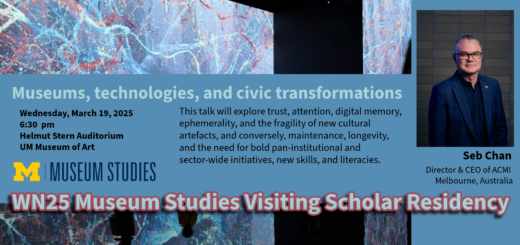Public programs facilitate dialogue between academics and professionals, informing scholarship and strengthening practice.
Multiple day conferences, year-long colloquia, individual lectures, “conversations” between individuals, hands-on workshops, and Museums at Noon talks featuring our graduate students all contribute to the remarkable richness of MSP offerings.
Video recordings of some MSP lectures are archived for viewing in our Media Gallery.

- This event has passed.
Global Interns: museum practice in Israel & Uganda
September 29, 2023 @ 12:00 pm - 1:00 pm
Global Interns: museum practice in Israel & Uganda
September 29 from 12:00 – 1:00 pm
Eldersveld Room, 5670 Haven Hall
Alexandra Norwood, PhD candidate, Anthropology
The Apes of Uganda: An Exhibit and Outreach Program at the Uganda Museum
Uganda is often called the Pearl of Africa, a phrase invoked by Winston Churchill describing the country: “for magnificence, for variety of form and color, for profusion of brilliant life – bird, insect, reptile, beast” (W. S. Churchill, 1909). Uganda’s remarkable biodiversity includes the presence of two species of living apes and a rich hominoid fossil record. Uganda’s importance to the evolution and conservation of great apes makes it essential to promote awareness and generate interest in protecting both fossil sites and the living apes.
The “Apes of Uganda” Exhibition and Outreach Project is the result of a collaboration between staff at the Uganda National Museum and biological anthropologists at the University of Michigan. The goal of this project was to share information about ape evolution in Uganda, the lives of chimpanzees and gorillas in Uganda’s National Park, and the importance of conserving both fossil sites and the National Parks where living apes are found. The exhibition at the Uganda National Museum opened in February 2023 and has been visited by ~ 100,000 visitors. A complementary schools outreach program carried out in July reached 18 Ugandan public primary and secondary schools in western Uganda, near National Parks where great apes live. The measured impact of these efforts teaches us valuable lessons about how to make this type of educational programming as effective as possible and demonstrates the importance of meaningful, outward-facing partnerships between researchers and museums.
Denisa Glacova, PhD student, Middle East Studies
Is ANU – Museum of the Jewish People Telling the Whole Story?
When asked about the ten-year-long renovation of ANU – Museum of the Jewish People in Tel Aviv, Dan Tadmor, the museum’s CEO explained that the conceptual, technological, artistic, and architectural overhaul was necessary to turn the institution into “the most comprehensive Jewish museum in the world.” Even its name was changed then – the former Beit Hatfutsot, or the Diaspora Museum, became ANU, i.e. we in Hebrew, reflecting its ambitious attempt to represent “all parts of the Jewish people.” Or, as Tadmor puts it, to “tell the whole story.”
In my short talk, I will reflect on my three-month internship at The Koret International School for Jewish Peoplehood in ANU. I will focus on ANU’s “vision of radical [Jewish] togetherness” and address its methodology and tools used to create an overarching exhibition narrative connecting Jewish histories and cultures throughout more than 4,000 years. Additionally, I will present a few possibilities to include stories pushed to the margins in the new three-store exhibition and to diversify the narrative of the current exhibition through educational programming in order to get closer to the – in my opinion – unattainable ideal of “telling the whole story.”


